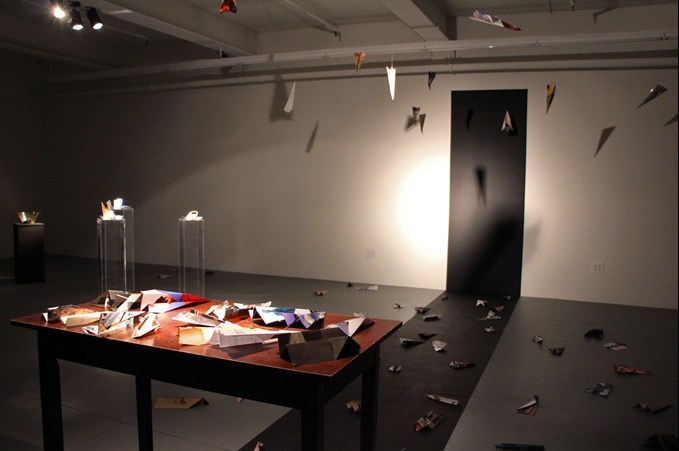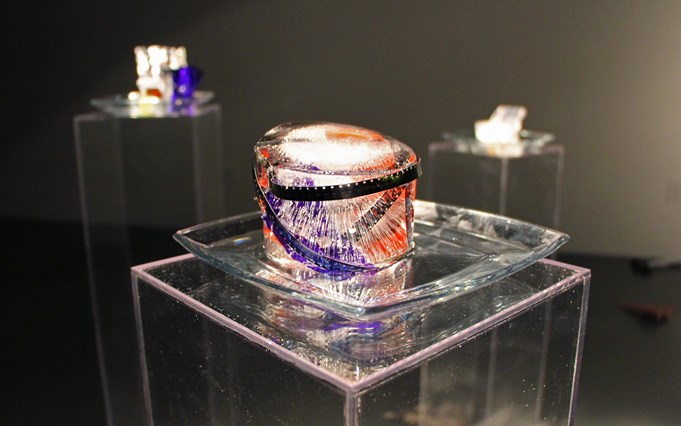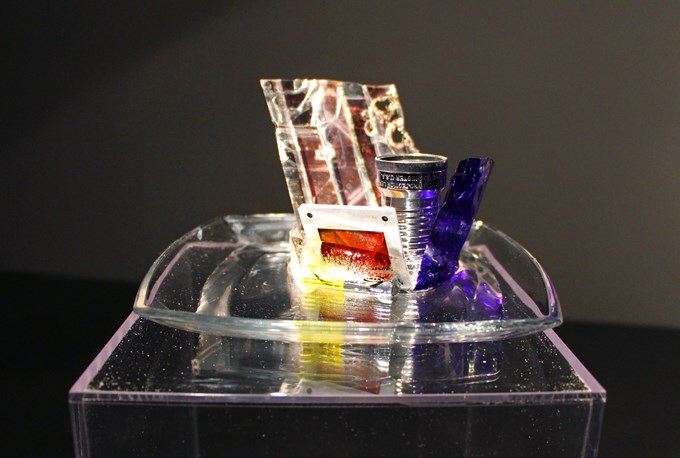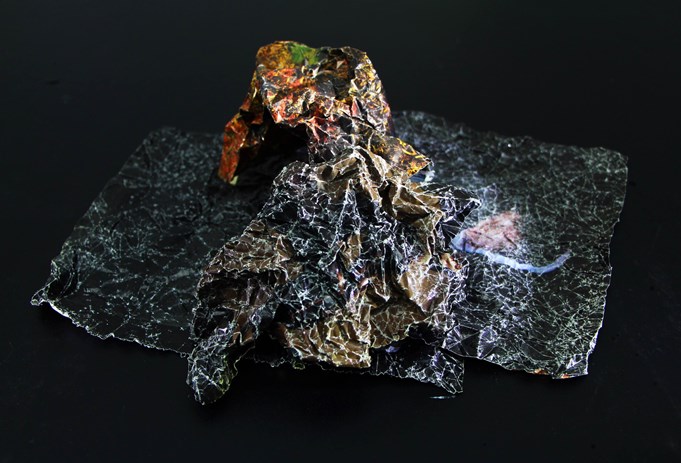
Spend five minutes speaking with Eros and you are convinced that he is one of those rare individuals, so consummately creative and interested in the farthest reaches of the arts, it is nearly impossible to imagine him as anything other than an artist. Working in film, video, collage and performance, Eros has created a name for himself as a boundary-breaker across mediums since the 1980s.
“Either the very hybrid or very pure versions of things are the ones I tend to like most, and for very different reasons,” comments Bradley Eros, while offering me a tour of his current exhibition at Microscope Gallery. Spend five minutes speaking with Eros and you are convinced that he is one of those rare individuals, so consummately creative and interested in the farthest reaches of the arts, it is nearly impossible to imagine him as anything other than an artist. Working in film, video, collage and performance, Eros has created a name for himself as a boundary-breaker across mediums since the 1980s. Citing Arte Povera as one of his longtime influences, his exhibition All that is solid melts into eros questions the ideas of possession and artwork as a stable, definable entity. Here his works reference the natural elements and are purposefully created to evolve, disappear and at times be replaced.
In our walk through, Eros casually postulates how one item could substitute for another and various ways the objects could relate for other conceptual purposes. Within the inner-workings of his mind, no creative opportunity is wasted. An ice sculpture melts down enough that the metal inside slides and its reflection shifts from the wall to the ceiling. A few moments earlier or later and a viewer would have seen only one side or the other of that change. Eros touches on the topic of happenstance, very relevant for an exhibition centered around audience interaction. He comes across as philosophical, but also grounded and relatable. He assures me that he does not want to limit audience participation in any way. I ask, “What would happen if I put one of the paper airplanes into my bag and walked out?” Bradley says decidedly, “I would not stop you,” and with a slight pause, adds a wry smile, “I may even encourage you to do it.”
ArtDependence Magazine: Your current exhibition at Microscope Gallery “All that is solid melts into eros” includes art made of ice, ash, paper, foil, and plastic that will be undone and remade daily. How does the lack of permanence and malleability of the materials inform the show?
Bradley Eros: The show incorporates the four elements of earth, air, fire and water. These elements are not fixed, any piece could shift from one to another element at some point. The paper you crumple could also be flown, burned, frozen or ultimately projected as an ash image. The pieces are interrelated through the archaeology of time - some disappear, others are altered and all recycle daily. Many have a second life because they are found objects or former analog technologies that are worked into the exhibition. An important part of the process is the audience interacting with the work, touching it, playing with it, making it their own in some way. Reconsidering these objects is a way we sharpen our perception of them.

Bradley Eros, "multiple planes of existence, HSHS: Harry Smith High School (3.16.18)", 2018, folded paper and foil, dimensions variable, installation view

Bradley Eros, "crumple (3.16.18)", 2018, wadded paper, dimensions variable

Bradley Eros, "multiple planes of existence, HSHS: Harry Smith High School (3.16.18)", 2018, folded paper and foil, dimensions variable
AD: The exhibition title references a Karl Marx quote, when “All that is solid melts into air…man is at last compelled to face...his real conditions of life, and his relations with his kind.” What does this exhibit compel your audience to realize?
BE: It is a playful title but the eros in the show’s name does not actually refer to me. It takes something heavy, the allusion to Marx, and brings a lightness to it. The show also has a somewhat solemn tenor but there is buoyancy too because you play with the materials. Though there is a gravity to the exhibition, there is eros in the sense of life, desire and making the experience of the works your own. Also, nothing is for sale in the show. There is an option to have a lease contract but no one can actually own a piece. You can only have them for a window of time because the works are intentionally ephemeral.
AD: The exhibit is devised around the concept of ephemerality in practice. How does that idea drive your broader oeuvre in film, video and performance?
BE: I have worked with unfixed films, performative film, even melting film or colored gels for projection, or I may use a fixed film but include a live music score. I like surprise and chance operations, as well as the fact that these moments are not precisely repeatable. Technically, we see it in the shift from analog to digital, as well as the difficulties of preserving film over time, but in many larger ways, permanence is a questionable idea.

Bradley Eros, "ice (3.16.18)", 2018, water, plastic, celluloid, metal, dimensions variable

Bradley Eros, "ice (3.16.18)", 2018, water, plastic, celluloid, metal, dimensions variable

Bradley Eros, "ice (3.16.18)", 2018, water, plastic, celluloid, metal, dimensions variable

Bradley Eros, "crumple (3.16.18)", 2018, wadded paper, dimensions variable
AD: Collaborations have been an important part of your noted film work. How does working with other artists and filmmakers impact your creativity and artistic production?
BE: Collaborating brings in an element of possibility and the unexpected. Working with others, often an alternating current of artists, musicians and filmmakers, adds interest and perspective to my art. I may begin with one idea in mind then move into something completely different through the process of joining thoughts and experimentation. Also, at times you back into something with a mistaken version that is even better than the perfect version, like a gritty film reel or flickering slides that you cannot predict or control but somehow, is just what you were looking for. It is important to embrace all failures and mistakes because they can open some wonderful doors.
AD: You have said: “Choosing liveness over permanence, I point to a philosophy of the living process, the present moment, non-possession, non-attachment and energy exchange.” Is your perspective an acceptance or a reverence of change?
BE: My vantage point accepts and celebrates ongoing change but at the same time, I am also mournful of extinction. There is a philosophical reflection on one’s own life - how you see time and experience through your own passage of it and the materiality of the self. Every time something gets destroyed, something else is made as a result, that is the cyclical ecology of the world. It all begins with a moment of consciousness and personal responsibility, then from that awareness, our personal choices and actions follow.
All images are courtesy of the artist and Microscope Gallery.
Image above: Bradley Eros, "ice (3.16.18)", 2018, water, plastic, celluloid, metal, dimensions variable

ArtDependence Magazine is an international magazine covering all spheres of contemporary art, as well as modern and classical art.
ArtDependence features the latest art news, highlighting interviews with today’s most influential artists, galleries, curators, collectors, fair directors and individuals at the axis of the arts.
The magazine also covers series of articles and reviews on critical art events, new publications and other foremost happenings in the art world.
If you would like to submit events or editorial content to ArtDependence Magazine, please feel free to reach the magazine via the contact page.